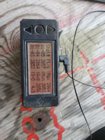Install the app
How to install the app on iOS
Follow along with the video below to see how to install our site as a web app on your home screen.
Note: This feature may not be available in some browsers.
You are using an out of date browser. It may not display this or other websites correctly.
You should upgrade or use an alternative browser.
You should upgrade or use an alternative browser.
I know, I know another load development question...Saterlee test
- Thread starter Lefty Trigger
- Start date
if you have no faith in something it will never work... if you dont believe it will work it wont work... if you dont understand something it wont work.... cant never did anything...if your brass prep doesnt get your es at 10fps or less in 5 shots with your best load its not going to workbut if you get your brass where you can load and keep sd and es down low the satterly method will work.... that flat spot in them numbers shows the same thing as the ocw test does with 2 or 3 powder charges impacting in the same place... makes me no difference how someone goes about doing load development as long as it gets them the results their looking for... but i wouldnt dismiss the satterly method... it works just fine for some of us... or being a newbie i get pretty lucky... 
I had fat fingers, I meant 38.6, good catch. If not 38.6, then 38.4/38.5? Seems that two charges in that range produced the same velocity. Asking, because. I’m getting ready to do a ladder test with 68gr Hornady in my .223 Rem 700.Because 38.6 isn't the middle of that node.
38.4 will probably put you in the middle of that node, that gives you .1+/- error rate.I had fat fingers, I meant 38.6, good catch. If not 38.6, then 38.4/38.5? Seems that two charges in that range produced the same velocity. Asking, because. I’m getting ready to do a ladder test with 68gr Hornady in my .223 Rem 700.
The last podcast Satterlee said he does a seating depth test first at the same charge weight.
See what shoots best, then do the charge weight at the seating that shot best.
See what shoots best, then do the charge weight at the seating that shot best.
Dusty Stevens
Shiner
That sounds like it would work a lot better. How does he do his seating depth test?The last podcast Satterlee said he does a seating depth test first at the same charge weight.
See what shoots best, then do the charge weight at the seating that shot best.
The last podcast Satterlee said he does a seating depth test first at the same charge weight.
See what shoots best, then do the charge weight at the seating that shot best.
Do you know what podcast that was?
Thanks.38.4 will probably put you in the middle of that node, that gives you .1+/- error rate.
Yes The Modern day sniper , episode # 14. he says to determine bullet jump first, shooting groups of 5 at various jumps, like .030",.060", .090",.120" something like that, its stated in the Berger manual, see how the groups look , pick the group that has like a triangle or like 5 holes like on a 5 spot dice. use that jump, then test charge weights with that jump.Do you know what podcast that was?
Similar threads
- Replies
- 18
- Views
- 4,621
- Replies
- 13
- Views
- 2,258
Upgrades & Donations
This Forum's expenses are primarily paid by member contributions. You can upgrade your Forum membership in seconds. Gold and Silver members get unlimited FREE classifieds for one year. Gold members can upload custom avatars.

Click Upgrade Membership Button ABOVE to get Gold or Silver Status.
You can also donate any amount, large or small, with the button below. Include your Forum Name in the PayPal Notes field.
To DONATE by CHECK, or make a recurring donation, CLICK HERE to learn how.

Click Upgrade Membership Button ABOVE to get Gold or Silver Status.
You can also donate any amount, large or small, with the button below. Include your Forum Name in the PayPal Notes field.
To DONATE by CHECK, or make a recurring donation, CLICK HERE to learn how.











